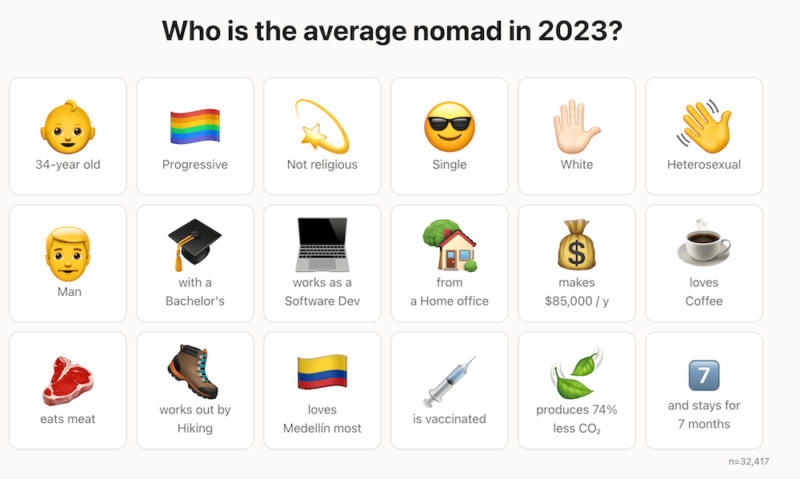- The United States has around 17.3 million digital nomads, accounting for 46% of all digital nomads worldwide.
- Millennials make up 37% of the digital nomad community.
- The average digital nomad is highly educated, with 54% of them holding a bachelor’s degree.
- The average income for digital nomads worldwide is more than $120,000 per year.
- The top three countries that digital nomads travel to are the United States, Thailand and Spain.
- The top three cities that digital nomads travel to are London, Bangkok and New York.
- The top industries in which digital nomads work are IT (19%), creative services (14%), education (9%) and sales, marketing and PR (9%).
- As many as 80% of digital nomads are highly satisfied with their work, and 82% of them are satisfied with their income.
- Hiking is the most popular outdoor activity for most digital nomads.
- As many as 59% of digital nomads want to continue their digital nomad journey in the coming years.
Facts & Expert Analysis: Digital Nomad Statistics
- Digital nomads are tech-savvy workers who have the freedom to travel and live in different places.
- The trend of digital nomadism became more prominent starting in 2014 because of the growth of coworking spaces, online communities and conferences focusing on remote work.
- Digital nomads tend to use technology to work remotely while traveling; they often do not have a permanent residence.
Freedom, flexibility and adventure are just some of the appealing aspects of the digital nomad lifestyle. If those are important to you, you may be interested in joining the more than 35 million digital nomads worldwide. However, before you turn your back on traditional office culture, let’s explore digital nomad statistics and trends to better understand this growing lifestyle.
In this article, we will uncover demographics, average income, the most visited countries, top professions and more about digital nomads worldwide. Keep reading to discover the interesting numbers and insights behind the digital nomad lifestyle.
Show allLearn more about our editorial team and our research process.
Digital Nomad Facts: What Is a Digital Nomad?
Digital nomads are tech-savvy individuals who work remotely and have the freedom to travel and live in different places. They take advantage of portable computing technologies like laptops, smartphones and widely available internet connections to complete their tasks while living a location-independent lifestyle.1
The idea of the digital nomad has been around for decades. Science fiction writer Arthur C. Clarke envisioned in as early as the 1960s9 that people might one day work from anywhere in the world. By the 1970s, the business world began to explore the idea of flexible working hours and a better work-life balance.2
In 1976, Jack Nilles’ introduced the concept of “telecommuting” as an IT-based alternative to commuting to work in his book ‘The Telecommunications-Transportation Tradeoff: Options for Tomorrow’.10
The term “digital nomad” finally emerged in 1997 in Tsugio Makimoto’s and David Manners’s textbook ‘Digital Nomad’.11 Digital nomadism became well known in 2014 and 2015 because of the growth of coworking spaces, online communities and conferences focusing on remote work.2

What Is the Difference Between a Digital Nomad and a Remote Worker?
Digital nomads tend to use technology to work remotely while traveling and exploring different locations. They often do not have a permanent residence. On the other hand, remote workers usually work from a fixed location like coworking spaces. They may not travel as frequently as digital nomads.
Digital Nomad Demographic Statistics
Let’s begin by exploring the latest demographic statistics about digital nomads. We will provide insights into the age, gender and country of origin of the people who choose the digital nomad lifestyle.

with the majority being male, white and highly educated.
1. How Many Digital Nomads Are There Around the World?
Counting the exact number of digital nomads around the world is challenging because they don’t officially register anywhere. The rate of usage of digital nomad visas, which allow remote workers to live and work abroad for a certain period of time, also remains unclear, with no concrete data.4
That said, a helpful source that gives us an idea of the number of digital nomads is the “2024 State of Digital Nomads” report, which gathers data from tens of thousands of members of the online digital nomad community Nomad List. According to this report, there were more than 35 million digital nomads worldwide in 2023.5
Though the exact number of digital nomads isn’t precise, it does indicate a growing trend of people embracing the digital nomad lifestyle.
2. Which Countries Are Most Digital Nomads From?
The United States is the leading country of origin for the majority of digital nomads. According to the “2023 State of Independence” research study by MBO Partners, approximately 17.3 million workers, or about 11% of the American workforce, currently identify as American digital nomads. Clearly, digital nomadism in the U.S. is not just a passing trend; it has become mainstream.3
Here are the top 10 countries from which most digital nomads originate worldwide:5
| 1 |  United States United States | 46% |
| 2 |  United Kingdom United Kingdom | 7% |
| 3 |  Russia Russia | 5% |
| 4 |  Canada Canada | 5% |
| 5 |  Germany Germany | 4% |
| 6 |  France France | 3% |
| 7 |  Brazil Brazil | 2% |
| 8 |  Australia Australia | 2% |
| 9 |  Netherlands Netherlands | 2% |
| 1 |  Spain Spain | 2% |
3. Is the Number of Digital Nomads Rising or Falling?
When we look at digital nomad statistics in the United States, we see a 2% increase from 2022. However, this growth is slower than during the pandemic years, which saw a significant, 131% increase in the number of digital nomads from 2019 to 2022.3
With advancements in remote work technologies and changing demographics, the global digital nomad growth trend is expected to continue. At the DNX Global Digital Nomad Conference in 2015, Pieter Levels estimated that there would be one billion digital nomads by 2035.4
4. Which Generation Dominates the Digital Nomad Community?
Millennials make up the majority (37%) of the digital nomad community. This is unsurprising given that Millennials are often referred to as digital natives.
Interestingly, the proportion of Millennial digital nomads dropped from 47% in 2022. As older Millennials hit middle age, they have more responsibilities and a greater need for financial stability. Additionally, more Gen Zers and individuals from older generations are joining the digital nomad movement, making the age range more diverse than ever before.3
In 2023, the breakdown of digital nomads by generation was as follows:
- Gen Y (born between 1981 and 1996) held the largest share, at 37%.
- Gen Z (born between 1997 and 2012) represented 21% of the digital nomad community.
- Gen X (born between 1965 and 1980) and Baby Boomers (born between 1946 and 1964) made up 42%.
5. How Has the Number of Gen Z Digital Nomads Changed Over Time?
In 2019, Gen Z (born between 1997 and 2012) accounted for less than 1% of digital nomads, indicating that the digital nomad movement was still relatively new to them. The oldest Gen Zers were just 22 years old at the time.
Over the past four years, more Gen Zers have joined the workforce. Today, 21% of digital nomads are Gen Zers. This increase in the number of digital nomads from this generation is also evident in their passion for travel. Research from Morning Consult highlights that 52% of Gen Z individuals are frequent travelers.3

flexibility that come with a nomadic lifestyle.
6. What Has Caused the Increase in Gen X and Baby Boomer Digital Nomads?
More Gen Xers and Baby Boomers are embracing digital nomadism. From 2022 to 2023, the number of older digital nomads increased from 36% to 42%. A major reason for this rise is the decline of the pandemic. Gen Xers and Baby Boomers are more comfortable traveling due to the fewer restrictions and health risks.
This shift in demographics has raised the average age of digital nomads to 39 years old. It was 37 in 2022 and 36 in 2020.3
7. What Is the Racial Composition of Digital Nomads Worldwide?
In 2024, digital nomad communities around the world have the following racial composition:5
Racial Composition of Worldwide Digital Nomads
8. Which Gender Is Most Represented Among Digital Nomads?
The majority of digital nomads are men (56%), followed by women (43%) and nonbinary people (about 1%).3
9. What Level of Education Do Most Digital Nomads Have?
Research indicates that the majority of digital nomads worldwide have completed higher education, with more than half holding a bachelor’s degree. Here are the proportions of different levels of education for digital nomads worldwide:5
- Bachelor’s degree — 54%
- Master’s degree — 34%
- High school education — 9%
- Doctoral degree — 3%
The 2023 MBO Partners report revealed that more than half of American digital nomads, or 52%, hold at least a college degree. This is higher than the 35% of all American adults.3
10. Are Digital Nomads More Likely to Be Single or to Have Families?
More than half (54%) of digital nomads are either married or living with a partner. Those with traditional jobs at companies are more likely to be married (61%) than independent contractors are (48%).3
However, a Nomad List survey based on relationship status reveals a different picture:5
- As many as 66% of digital nomads reported being single.
- A total of 34% are in a relationship.
11. Do Digital Nomads Travel with Their Children?
Perhaps surprisingly, 24% of American digital nomads travel with their children. They believe that by living a nomadic lifestyle, their children will experience the joy of adventure, discover new things, meet new people and learn about different cultures. They will also gain important skills like adaptability and resilience.3
Digital Nomad Financial Statistics
Next, let’s explore the latest digital nomad statistics on finances to understand how they earn and handle their money. We’ll also delve into their income levels and the impact they have on the places where digital nomads choose to work.
12. What Is the Average Digital Nomad’s Income Worldwide?
Digital nomads worldwide make an average income of more than $120,000 per year, as per a Nomad List member survey. Here’s the breakdown:5
- A total of 35% earn between $100,000 and $250,000 per year.
- A total of 34% earn between $50,000 and $100,000 per year.
- A total of 15% earn between $25,000 and $50,000 per year.
- A total of 8% earn between $250,000 and $1 million per year.
- A total of 6% earn less than $25,000 per year.
In the United States, digital nomads earn varying amounts. According to the 2023 MBO Partners report, approximately 42% of American digital nomads make $75,000 or more per year, while 19% report a household income of less than $25,000 annually.3
13. Are Digital Nomads Satisfied With Their Income?
The majority of digital nomads (82%) express satisfaction with their income, with 47% reporting being very satisfied and 35% satisfied. In contrast, only 69% of workers who aren’t digital nomads report satisfaction with their income.
Interviews for the 2023 MBO Partners report show that digital nomads are generally satisfied with their income, even if it’s not a significant amount, as long as it covers their travel expenses.3
14. How Do Digital Nomads Budget for Constant Travel?
Many digital nomads leverage the difference in the cost of living between their work location and the markets they serve. Many digital nomads prefer to work in places with a lower cost of living while serving customers or working for employers in higher-wage countries. This allows them to fund their travels while spending fewer hours working to support themselves.3
15. What Are the Most Common Revenue Streams for Digital Nomads?
Some of the most common revenue streams for digital nomads include:4
- Freelancing: Many digital nomads tap into the gig economy as freelancers, taking on short-term projects or working on project-specific contracts.
- Content creation: A total of 40% of digital nomads earn money in the creator economy, such as through blogging, vlogging or podcasting.3
- Online businesses: Dropshipping is a popular entrepreneur approach that many digital nomads use to generate income. This method lets them sell online without handling inventory or shipping. Amazon is a major platform and distribution channel for dropshipping companies.
- Remote jobs: Many digital nomads work remotely for traditional companies, often in roles that allow for location independence. Some travel through work as employees and have multiple professions.
16. How Does Location Affect Remote Work Income?
Location isn’t affecting income as much as it used to:8
- A total of 43% of remote workers say that their paycheck isn’t tied to their location — an increase from the 38% reported last year.
- As many as 35% report that their income is still tied to their location.
- A total of 22% are uncertain.
Additionally, another current trend brings good news about pay equality:8
- Though down slightly from 73% last year, 70% of remote workers report no pay cut for choosing to work remotely.
- A total of 8% acknowledge reduced pay compared to 6% in the previous year.
- A total of 22% are unsure whether remote workers at their company earn less.
These positive financial trends bring good news for digital nomads, especially those with traditional jobs. This means that they can travel and work while maintaining a stable income.
17. How Are Companies Financially Supporting Their Remote Workers?
According to Buffer’s “State of Remote Work 2023” report, companies are stepping up in many ways to financially support their employees worldwide, especially regarding essential remote work equipment for productive home offices. For instance:
- Employers pay for remote workers’ hardware, such as monitors and mice, at a rate of 64%.
- Companies fund office furniture like desks and chairs at a rate of 40%.
Additionally, companies cover home internet costs for remote workers at a rate of 28%. Employers also offer financial support for coworking spaces at a rate of 22%. However, there’s a notable portion of the workforce that either wants more support in these areas or finds that this support is not a dealbreaker for their remote work setup.8
Though many organizations lack official policies and programs for their digital nomad workforce, a growing number of these workers are forcing businesses to acknowledge and interact with them. This is creating opportunities for cooperatives and financial support.
Digital Nomad Travel Statistics
Let’s take a close look at the travel side of digital nomad statistics. We’ll find out where they are going, how often they move around, the kinds of places they like to stay in and more.
18. Which Countries Do Digital Nomads Visit the Most Worldwide?
The United States, Spain and Thailand top the list as the countries that digital nomads visit the most worldwide.
Here’s the list of the top 10 countries that digital nomads visit the most:5
| 1 |  United States United States | 15% |
| 2 |  Spain Spain | 5% |
| 3 |  Thailand Thailand | 5% |
| 4 |  United Kingdom United Kingdom | 4% |
| 5 |  Germany Germany | 4% |
| 6 |  Mexico Mexico | 4% |
| 7 |  France France | 3% |
| 8 |  Italy Italy | 3% |
| 9 |  Portugal Portugal | 3% |
| 10 |  Indonesia Indonesia | 2% |
19. Which Cities Do Digital Nomads Visit the Most Worldwide?
London, Bangkok and New York are the cities that digital nomads visit the most worldwide.
Here’s the list of the top 10 cities that digital nomads visit the most:5
| 1 | London | 2.32% |
| 2 | Bangkok | 1.99% |
| 3 | New York | 1.57% |
| 4 | Berlin | 1.53% |
| 5 | Lisbon | 1.51% |
| 6 | Paris | 1.50% |
| 7 | Barcelona | 1.48% |
| 8 | Amsterdam | 1.29% |
| 9 | San Francisco | 1.21% |
| 10 | Chiang Mai | 1.1% |
20. Which Countries Do Digital Nomads Like the Most Worldwide?
Malaysia and Poland attract digital nomads the most and receive the highest ratings. These countries are followed by Italy, Colombia and Japan.
Here’s the list of the top 10 countries that digital nomads like the most worldwide, based on factors such as job opportunities, cost of living, internet speed and quality of life:5
| 1 |  Malaysia Malaysia | 4.8 |
| 2 |  Poland Poland | 4.8 |
| 3 |  Italy Italy | 4.75 |
| 4 |  Colombia Colombia | 4.75 |
| 5 |  Japan Japan | 4.75 |
| 6 |  South Korea South Korea | 4.65 |
| 7 |  France France | 4.6 |
| 8 |  Spain Spain | 4.6 |
| 9 |  Germany Germany | 4.55 |
| 10 |  Georgia Georgia | 4.55 |
21. Which Countries Do Digital Nomads Like the Least Worldwide?
Digital nomads rated Iran and Honduras the lowest worldwide, followed by Lithuania.
Here’s the list of the top 10 cities that digital nomads like the least based on factors such as job opportunities, cost of living, internet speed and quality of life.5
| 1 |  Iran Iran | 1.65 |
| 2 |  Honduras Honduras | 1.65 |
| 3 |  Lithuania Lithuania | 2 |
| 4 |  Barbados Barbados | 2.5 |
| 5 |  Cameroon Cameroon | 2.5 |
| 6 |  North Korea North Korea | 2.5 |
| 7 |  Gibraltar Gibraltar | 2.5 |
| 8 |  Senegal Senegal | 2.5 |
| 9 |  Malta Malta | 2.5 |
| 10 |  Chile Chile | 2.5 |
22. Which Cities Do Male Digital Nomads Like the Most Worldwide?
Porto, Barcelona and Madrid are the cities that male digital nomads like the most worldwide.
Here’s the list of the top five cities that male digital nomads like the most based on factors such as job opportunities, cost of living, internet speed and quality of life.5
| 1 | Barcelona | 4.64 |
| 2 | Porto | 4.62 |
| 3 | Madrid | 4.58 |
| 4 | Budapest | 4.55 |
| 5 | Tbilisi | 4.50 |
23. Which Cities Do Female Digital Nomads Like the Most Worldwide?
Playa del Carmen is the city that female digital nomads like the most, receiving the highest rating of 4.00. Following Playa del Carmen are 12 cities that received an equal rating of 3.75, including Chiang Mai and Medellín.5
Here’s the list of the top five cities that female digital nomads like the most based on factors such as job opportunities, cost of living, internet speed and quality of life.5
| 1 | Playa del Carmen | 4.00 |
| 2 | Chiang Mai | 3.75 |
| 3 | Medellín | 3.75 |
| 4 | Berlin | 3.75 |
| 5 | Tbilisi | 3.75 |
24. How Do Digital Nomads Choose Their Destinations?
Digital nomads often choose locations that combine tourist appeal like coastal countries with practical work needs such as a high-speed internet connection. Furthermore, digital nomads prefer destinations with a lower cost of living than their home country or country of employment.
Some of the most referenced and studied digital nomad destinations include countries in Southeast Asia like Cambodia and Thailand, major cities in South America such as Buenos Aires and Medellín and the historic urban locales of Berlin and Lisbon.4
25. How Long Do Digital Nomads Stay in One City?
Most digital nomads spend less than one week in a city.5
How Long Digital Nomads Stay in One City
26. How Long Do Digital Nomads Stay in One Country?
Most digital nomads spend between seven and 30 days in a country.5
There is also a growing segment of digital nomads known as “slomads,” who choose to settle down in a location for a longer period and visit fewer places compared to most digital nomads. This lifestyle choice allows them to fully immerse themselves in the local culture, reduce the stresses of frequent travel and achieve a better work-life balance.3
How Long Digital Nomads Stay in One Country
27. Which Countries Offer Digital Nomad Visas?
Europe is the leading continent offering digital nomad visas. Countries such as Croatia, Cyprus, Estonia, Greece, Hungary, Malta, Portugal and Romania have introduced special visas or permits that allow remote workers to live and work legally for an extended period.
Other countries outside of Europe, like Belize, Brazil, Costa Rica, the Dominican Republic, Ecuador, Japan, Germany and the Seychelles, have also launched digital nomad-friendly visas to attract remote workers and boost their economies.
28. What Are the Requirements to Obtain a Digital Nomad Visa?
The specific requirements to obtain a digital nomad visa vary depending on the country. Here are some common requirements to obtain a digital nomad visa:4,7
- Applicants must be over 18 years of age.
- Applicants must provide proof of employment or self-employment.
- Applicants must be able to prove income sources. The required amount varies depending on the country. Most income criteria are stated in USD or EUR and are listed as monthly or annual income.

digital nomads who are working remotely.
Digital Nomad Profession Statistics
What kinds of jobs do digital nomads have? Are they satisfied with their work? Let’s learn the answers to these questions and explore more statistics on digital nomads’ professions.
29. How Do Employment Types Break Down Among Digital Nomads?
According to the 2023 MBO Partners report, about 68% of digital nomads are full-time remote workers, while 32% work part-time.3
Additionally, the “2024 State of Digital Nomads” report provides a more detailed breakdown:5
- Full-time employees — 42%
- Freelancers — 17%
- Startup founders — 16%
- Full-time contractors — 9%
- Part of agencies — 7%
- Other categories — 5%
- Part-time employees — 2%
- Part-time contractors — 2%
30. In What Fields Do Digital Nomads Work?
Digital nomads work in a wide range of fields that allow them to work remotely using digital tools and an internet connection. According to the 2023 MBO Partners report, their professional landscape can be broken down as follows:3
- Information technology and computer sciences — 19%
- Creative services — 14%
- Education and training — 9%
- Sales, marketing and PR — 9%
- Finance and accounting — 8%
- Consulting, coaching and research — 7%
31. Which Professions Do Male Digital Nomads Work in the Most?
The top professions for male digital nomads worldwide include software developer, web developer and startup founder.
Here’s a list of the top five professions for male digital nomads:5
| 1 | Software developer | 34% |
| 2 | Web developer | 28% |
| 3 | Startup founder | 27% |
| 4 | Marketing professional | 15% |
| 5 | SaaS | 13% |
32. Which Professions Do Female Digital Nomads Work in the Most?
Marketing professional, creative and startup founder are the top professions for female digital nomads.5
Here’s the list of the top five professions for female digital nomads:5
| 1 | Marketing professional | 15% |
| 2 | Creative | 15% |
| 3 | Startup founder | 12% |
| 4 | Software developer | 10% |
| 5 | UI/UX designer | 8% |
33. Which Skills are in High Demand Among Digital Nomad Job Markets?
The most in-demand skills among digital nomads worldwide are those related to technology, such as software development, computer sciences, digital marketing and graphic design.
Furthermore, skills in social media management and content creation are in high demand. Gig workers and freelancers also benefit from possessing other important skills, like project management, language proficiency and communication.3
34. Are Digital Nomads More Likely to Be Independent Workers or Traditionally Employed?
Digital nomads are more likely to be independent workers than traditionally employed. In 2023, the number of nomads who were freelancers or running their own businesses increased by 14% compared to the previous year. This movement is gaining momentum, with 27% of digital nomads planning to transition into independent work in the coming years.
Meanwhile, there has been a 4% decrease in the number of traditionally employed digital nomads. The rise of the hybrid work model, which requires that remote employees spend some time working in an onsite office, has contributed to this decline.3
35. Are Digital Nomads Satisfied With Their Work?
Digital nomads stand out as the most satisfied workers. According to a recent survey, 80% of digital nomads report feeling highly satisfied with their work, and 9% report being satisfied. In comparison, about 59% of non-digital nomads say they’re highly satisfied and 17% say they’re satisfied with their work.
This high level of satisfaction is attributed to the freedom and flexibility that come with a digital nomad lifestyle. Digital nomads have more control over their work-life balance. Moreover, 79% of digital nomads are optimistic about their future careers.3
36. Where Do Digital Nomads Work From the Most Worldwide?
Nomad List’s survey shows that home offices are the most common location for digital nomads to work from, followed by coworking spaces and cafes.5
| 1 | Home office | 60% |
| 2 | Coworking space | 15% |
| 3 | Café | 8% |
| 4 | Office | 6% |
| 5 | Dining table | 4% |
Similarly, Buffer’s “State of Remote Work 2023” report revealed that home offices make up 82% of the most popular locations for remote workers.8

Digital Nomad Lifestyle Statistics
We will take a closer look at digital nomads’ lifestyles to gain insight into those statistics. This section will include their activities, challenges, future trends and more.
37. What Are Digital Nomads’ Favorite Leisure Activities?
Data on the Nomad List’s digital nomad members reveals that they have a preference for outdoor activities like hiking and fitness. Digital nomad women also like to go to the beach. Another popular leisure activity among male and female digital nomads is reading.5
38. Which Sports Activities Are Popular Among Male Nomads?
Hiking, fitness and running are the most popular sports activities among male digital nomads worldwide.5
Here’s a list of the top five most popular sports activities among male nomads:
| 1 | Hiking | 49 |
| 2 | Fitness | 48% |
| 3 | Running | 29% |
| 4 | Cycling | 25% |
| 5 | Swimming | 24% |
39. Which Sports Activities Are Popular Among Female Nomads?
Hiking, yoga and fitness are the most popular sports activities among digital nomad women worldwide.5
Here’s a list of the top five most popular sports activities among female digital nomads:
| 1 | Hiking | 52% |
| 2 | Yoga | 44% |
| 3 | Fitness | 40% |
| 4 | Swimming | 24% |
| 5 | Running | 21% |
40. What Do Digital Nomads Eat?
Most digital nomads worldwide identify as meat eaters. Let’s take a closer look at their dietary preferences:
- Meat eaters — 75% of digital nomad men and 56% of digital nomad women
- Non-meat eaters — 38%
- Vegetarian — 12%
- Vegan — 12%
- Pescetarian — 5%
A significant proportion of digital nomads consider themselves coffee lovers, with 39% of men and 30% of women identifying as such.5
41. What Are the Motivations Behind Becoming a Digital Nomad?
Freedom is a key motivating factor for individuals who choose to become digital nomads. They want to break free from the constraints of traditional work environments and explore their inner selves. Many aspiring digital nomads also want to escape the corporate world.
Additionally, lifestyle-related motivations like location independence, novelty and achieving a better work-life balance play significant roles.4
42. What Are the Top Challenges that Digital Nomads Face?
The 2023 MBO Partners report highlights several challenges that digital nomads face, including the following:3
- Personal safety — 26%
- Managing work and travel — 24%
- Being away from family and friends — 22%
- Time zone differences that make work difficult — 21%
- Loneliness — 21%
- Travel logistics — 19%
Fortunately, there was a decrease in the number of digital nomads reporting these challenges in 2023. The end of the pandemic has reduced safety risks, improved travel logistics and made it easier for digital nomads to visit family and friends.3
43. Are Digital Nomads Likely to Continue Their Nomadic Lifestyle in the Coming Years?
In 2023, it was reported that most digital nomads are likely to continue their nomadic lifestyle in the coming years.
Whether Digital Nomads Plan to Continue Lifestyle
However, the number of digital nomads who intend to continue their nomadic lifestyle decreased from 69% in 2022. That said, the percentage is still higher than those reported in 2021 (54%) and 2020 (49%). Additionally, many former digital nomads say that they will return to digital nomadism at some point in the future.3
44. Why Do Some Digital Nomads Choose to Discontinue Their Digital Nomadism?
- Company policies that require remote employees to go back to the office have made many digital nomads less confident in their plans to continue. Digital nomads who are traditional workers became less certain about living the digital nomad life in 2023, whereas those with independent jobs were just as likely to continue as they were the previous year.
Other top reasons for discontinuing digital nomadism include traveler fatigue, finding travel too expensive and facing logistical challenges. Some digital nomads may also experience feelings of isolation and missing their family and friends. Additionally, there are difficulties in maintaining a work-life balance.3
45. How Many Individuals Plan to Become Digital Nomads in the Near Future?
In 2023, a significant number of individuals reported that they planned to become digital nomads in the near future. Here are the key digital nomad stats:
- Over the next two to three years, 24 million non-digital nomads plan to become digital nomads.
- As many as 46 million people say they may become digital nomads at some point.
It is worth noting that these figures represent a slight decrease of 3% compared to the previous year.
The study also shows that only about 7% to 9% of people who say they are interested will actually follow through and become digital nomads. The rest continue to be “armchair digital nomads,” or people who follow others’ experiences with digital nomadism without becoming digital nomads themselves.3
The Future of the Digital Nomad Life
Digital nomad statistics and trends show that the number of digital nomads globally will continue to grow. More Gen Zers will lead a nomadic lifestyle. Additionally, there will be greater diversity among digital nomads, including variations in age, gender and profession.
Remote work is here to stay, and digital nomads are still driving the workplace revolution. Many companies are embracing the benefits of remote work and the flexibility it offers. As a result, there is an increase in the availability of remote employment opportunities.
The future of digital nomadism is bright. However, this growth also prompts a stronger focus on regulating and legislating the digital nomad lifestyle. Governments worldwide are introducing laws and regulations to address tax implications, digital nomad visa requirements and other legal aspects to ensure the seamless integration of digital nomads into various countries.
Final Thoughts
Digital nomadism offers a blend of adventure, work and flexibility that appeals to many people. The ability to work from home or anywhere in the world allows digital nomads to explore new cultures and experiences while still earning a living. Remote work also improves work-life balance by giving individuals more control over their schedules.
On the flip side, this freedom is not without its challenges. Maintaining a stable income, dealing with constant change and finding a work-life balance can be difficult. Being a digital nomad requires careful planning, adaptability and financial freedom. Nevertheless, for those willing to embrace uncertainty and adapt to new environments, the rewards can be well worth it.
What are your thoughts on the future of the digital nomad life? Have you considered becoming a digital nomad yourself? How do you think this lifestyle will continue to evolve in the coming years? Share your insights and experiences in the comments below. Thank you for reading!
FAQ: Digital Nomad Statistics
- What Is a Digital Nomad?
A digital nomad is an individual who uses technology to work remotely and who has the freedom to travel and live in different locations around the world. Digital nomads rely on online tools and a reliable internet connection to carry out their work.
- How Much Do Digital Nomads Make?
Digital nomads’ income is highly variable. A total of 35% of digital nomads worldwide make between $100,000 and $250,000 per year.6 In the United States, 42% make $75,000 or more per year.3
- How Many Digital Nomads Are There?
The number of digital nomads worldwide is difficult to determine precisely, as they don’t officially register anywhere. However, according to Nomad List’s “2024 State of Digital Nomads” report, there are currently more than 35 million digital nomads worldwide.5
- How Can I Become a Digital Nomad?
First, you need to assess your skills and determine whether they can be transferred to remote work. Then, you can start looking for remote work opportunities or freelance gigs that allow you to work from anywhere. Additionally, be sure to save money and create a financial plan to support your nomadic lifestyle. Finally, it’s important to research and choose your destinations wisely.
Sources:
- Digital nomads: freedom, responsibility and the neoliberal order — Semantic Scholar
- The History of Digital Nomadism — Schlagwein, Daniel
- Digital Nomads: Nomadism Enters the Mainstream — MBO Partners
- Digital Nomads: Toward a Future Research Agenda — Nick Dreher & Anna Triandafyllidou
- 2024 State of Digital Nomads — Nomad List
- Digital Nomadism: Transnational Economic Relations in the Emerging Economies — Harvard
- Digital Nomad Visa – Countries Offering Visas for Digital Nomads
- State Of Remote Work 2023 — Buffer
- Arthur C. Clarke Predicts the Internet in 1964 — YouTube
- The Telecommunications-Transportation Tradeoff: Options for Tomorrow — Jack M. Nilles
- Digital Nomad — Tsugio Makimoto, David Manners
The post Digital Nomad Statistics, Trends & Facts for 2024: How Remote Working is Changing appeared first on Cloudwards.
 11 months ago
159
11 months ago
159

